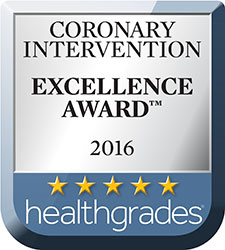Healthgrades has recognized EIRMC as Top 10% in the Nation for Coronary Intervention Excellence, and awarded us a five-star rating for 2016.

At EIRMC, patients needing cardiac catheterization have the option for a transradial approach, or entry at the wrist instead of the groin. This can reduce complications, decrease bleeding, and promote faster recovery.
Fewer than 15% of heart programs in the United States offer this option; in fact, EIRMC physicians routinely train doctors from across the country on this technique. EIRMC has the highest volume of transradial catheterizations in the Intermountain West.

Benefits include:
- Decreased bed rest after the procedure. Even when an intervention is performed and a stent is placed, an overnight stay is required. However, the amount of time a patient must remain on bed rest is reduced.
- Fewer activity limitations. As long as the patient doesn’t use their affected wrist, they are able to sit and change position as needed to increase comfort: head or legs can be elevated to any level, patient can lie on their side, and even get out of bed to walk or use the restroom (following short bed rest).
- Lifting/pulling/pushing restrictions limited to the affected arm. The weight restriction following radial catheterization is only 20 lbs. for the affected arm. This typically has very little impact on lifestyle or career.
- Less risk for bleeding. The radial artery is much smaller than the femoral artery, so the amount of post-procedure bleeding is considerably less. Some patients don’t experience any bleeding. The radial approach also allows for more control if some bleeding should occur, since direct pressure on the wrist is easier to maintain than on the femoral area of the groin. The patient may simply elevate their arm to maintain control over bleeding, rather than lying flat to achieve the same effect.
- More options for positioning during the procedure. During the procedure, the arm is the only part of the body that must remain straight and in position. For patients with back problems, or those who have difficulty breathing , experience anxiety or have pain while lying flat, this approach offers more comfort.